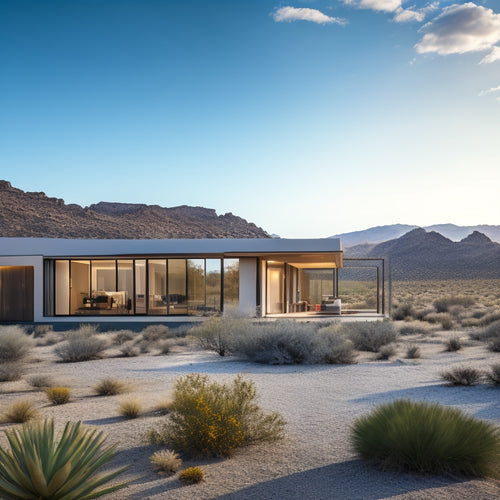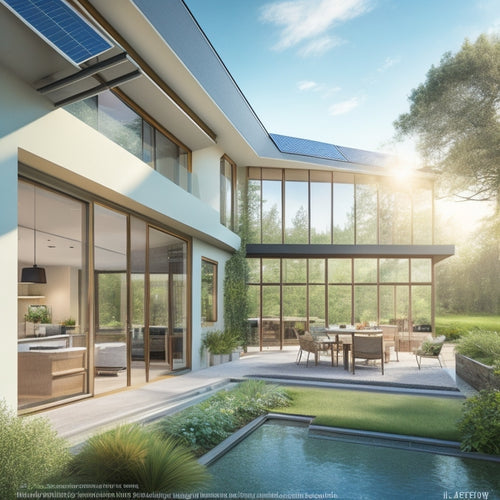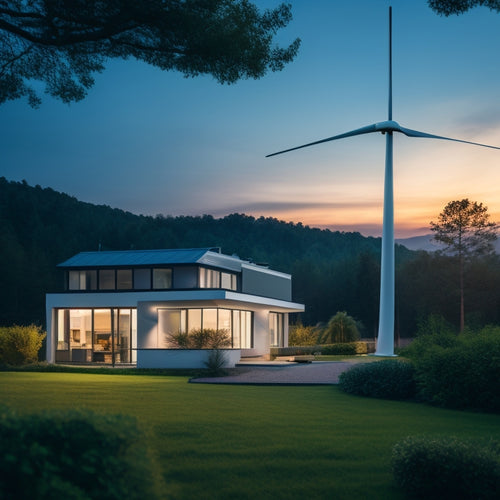
What Are Smart Windows? Self-Tinting Glass Explained
Share
You're about to uncover how smart windows, also known as self-tinting glass, use adaptive glazing technology to adjust transparency, color, or reflectivity in real-time, responding to sunlight and changing the way you control light and heat in your living or working space. This innovative technology enables real-time adjustments via smart technology, providing you with control over light and heat for enhanced comfort and flexibility. By understanding how smart windows work, you'll reveal the benefits of self-tinting glass, from energy efficiency to cost savings, and learn how to take advantage of this advanced technology to enhance your space and lifestyle.
Key Takeaways
- Smart windows, also known as self-tinting glass, adjust transparency, color, or reflectivity in real-time using adaptive glazing technology.
- They utilize environmental sensors and smart technology to optimize light and heat management for enhanced comfort and energy efficiency.
- Smart windows can integrate with solar-powered solutions and smart home systems, promoting sustainability and enhancing user experience.
- They reduce reliance on artificial lighting and HVAC systems, contributing to environmental sustainability and significant energy savings.
- Smart windows provide users with control over light and heat entering a space, improving aesthetics, comfort, and overall living or working experience.
How Smart Windows Work
When you interact with smart windows, they respond by adjusting their transparency, color, or reflectivity in real-time, often in response to your voice commands, gestures, or environmental changes.
This is made possible by the integration of smart technology and adaptive glazing, which enables the windows to adapt to your needs. The adaptive glazing technology allows the window's tint to change depending on the amount of sunlight it receives, while the smart technology enables real-time adjustments based on your preferences.
By leveraging renewable energy solutions, smart windows can also help reduce our reliance on fossil fuels and minimize carbon footprint.
This seamless interaction gives you control over the amount of light and heat that enters your space, providing you with an unparalleled level of comfort and flexibility.
Benefits of Self-Tinting Glass
Improved design aesthetics: Self-tinting glass seamlessly integrates with any design style, providing a sleek and modern look that enhances the beauty of your space.
Additionally, incorporating eco-friendly features like green roofs and rainwater harvesting systems can further enhance the design of your space.
-
Increased flexibility: You can adjust the tint level to suit your mood, activity, or time of day, giving you complete control over your environment.
-
Alignment with market trends: Self-tinting glass is a state-of-the-art technology that aligns with the latest market trends, making your space stand out from the rest.
Its ability to adapt to changing environmental conditions, much like renewable energy sources, adds to its appeal.
- Enhanced user experience: With self-tinting glass, you can enjoy a more comfortable and convenient living or working space that adapts to your needs.
Energy Efficiency in Homes
As you investigate the benefits of self-tinting glass, you'll uncover its significant impact on energy efficiency in homes. By incorporating self-tinting glass into your home's design, you can reduce your reliance on artificial lighting and heating/cooling systems. This is achieved through passive design, where the glass adapts to changing environmental conditions, optimizing thermal performance and minimizing energy consumption.
In addition, self-tinting glass can also contribute to a healthier planet by reducing fossil fuel reliance, which is essential for environmental sustainability. Moreover, it can also improve grid resilience by reducing strain during peak hours through decentralized energy generation.
In warm weather, self-tinting glass reduces heat gain, decreasing the need for air conditioning. In cooler weather, it allows natural light to enter, reducing the need for artificial lighting and heating. This results in significant energy savings and a reduced carbon footprint, giving you the freedom to live more sustainably.
Controlling Light and Heat
Smart window technology gives you precise control over the amount of light and heat that enters your home, allowing you to fine-tune the internal environment to your liking.
With smart windows, you can optimize light management and heat reduction to create a comfortable and energy-efficient space. By incorporating renewable energy sources, such as hydroelectric power plants, you can further reduce your carbon footprint and energy consumption.
Additionally, utilizing energy storage systems, like batteries, can stabilize the grid and guarantee a reliable energy supply. You can adjust the tint level to block out harsh sunlight, reducing heat gain and minimizing the need for air conditioning.
You can also let in natural light, reducing the need for artificial lighting and creating a brighter, more inviting atmosphere. Smart windows can reduce glare, making it easier to work or relax in front of a window.
Smart Glass Technology Advantages
You step into a room with smart glass technology, and immediately notice the difference. The ambiance is more comfortable, and the view is unobstructed.
Smart glass technology advantages extend beyond aesthetics, offering a range of benefits that improve your overall experience. For instance, you enjoy enhanced privacy, reduced glare, and optimized natural light.
Additionally, the integration of smart glass technology with solar-powered charging solutions can further reduce carbon footprint and energy costs.
As buildings and structures continue to evolve towards sustainability, smart glass technology is ready to play a significant role in shaping the future of building design.
With its ability to actively adapt to changing environmental conditions, smart glass is an attractive solution for those seeking freedom from traditional glass limitations.
Cost Savings and ROI
By incorporating smart glass technology into building design, you can reap significant cost savings and a substantial return on investment (ROI).
A financial analysis of smart window installations reveals that they can lead to considerable investment returns.
-
Reduced energy consumption: Smart windows minimize the need for artificial lighting and heating/cooling, resulting in lower energy bills.
-
Extended HVAC system lifespan: By reducing the load on heating and cooling systems, smart windows help prolong their lifespan.
-
Increased property value: The installation of smart windows can enhance a property's value, making it more attractive to potential buyers or renters.
- Reduced maintenance costs: Smart windows are designed to be low-maintenance, reducing the need for frequent repairs and replacements.
Installation and Maintenance Tips
When installing smart windows, you'll want to verify proper window alignment to maximize energy efficiency and prevent premature wear.
You'll also need to establish a regular cleaning and care routine to maintain the window's electrochromic coating and ascertain peak performance.
Proper Window Alignment
Proper window alignment is essential to guaranteeing smart windows function at their best, as even slight misalignments can lead to compromised performance and reduced energy efficiency.
When installing your smart windows, you'll want to pay close attention to their orientation and frame adjustment to guarantee peak performance.
Here's what you need to check:
- Verify that the window is installed at the correct angle to allow for proper solar gain and heat dissipation.
- Confirm the frame is level and plumb to prevent stress on the window's mechanical components.
- Check that the window is securely fastened to the surrounding frame to prevent air leaks and moisture intrusion.
- Adjust the window's frame to accommodate any settling or shifting of the building over time.
Cleaning and Care
You've guaranteed your smart windows are properly aligned, now it's time to focus on maintaining their ideal performance through regular cleaning and care.
To promote peak functionality, it's crucial to use the right cleaning techniques. Avoid using harsh chemicals, abrasive materials, or high-pressure washes, as they can damage the self-tinting glass.
Instead, gently wipe the windows with a soft cloth and a mild soap solution. For more thorough cleaning, use a specialized glass cleaner and a microfiber cloth.
Follow the care instructions provided by the manufacturer to maintain the windows' warranty.
Future of Sustainable Windows
As the world shifts towards a more environmentally conscious era, one essential aspect of sustainable design is taking center stage: the future of windows.
You're likely wondering what advancements are on the horizon. The future of sustainable windows lies in innovative materials and designs that prioritize energy efficiency, reduce carbon footprint, and promote eco-friendliness.
Some exciting developments to look out for include:
- Future materials that can capture solar energy while maintaining transparency
- Design innovations that integrate natural ventilation and insulation
- Windows with built-in air purification systems to improve indoor air quality
- Self-healing glass that can repair scratches and cracks autonomously
Frequently Asked Questions
Can Self-Tinting Glass Be Installed in Existing Window Frames?
You can install self-tinting glass in existing window frames, but it depends on the frame's compatibility with the self-tinting technology; measure carefully and consult with a professional to guarantee a seamless integration.
How Long Does It Take for Smart Windows to Change Tint?
You'll wait an eternity (okay, more like 5-10 minutes) for smart windows to change tint, but the payoff is worth it: a seamless tint change that enhances energy efficiency, giving you the freedom to bask in natural light or shade, as you please.
Are Smart Windows Compatible With Smart Home Systems?
You can seamlessly integrate smart windows with your smart home system, releasing enhanced energy efficiency and cost savings. By automating tint adjustments, you'll optimize natural light and temperature control, liberating you to focus on what matters most.
Can Smart Windows Be Used in Skylights and Roof Windows?
You can install smart windows in skylights and roof windows, optimizing energy efficiency and light control. By doing so, you'll regulate the amount of natural light entering your space, reducing heat gain and loss, and enjoying greater freedom in your daily life.
Are There Any Health Benefits to Using Smart Windows?
You'll reap health benefits from smart windows, which provide energy efficiency and UV protection, reducing eye strain and skin damage, while also promoting overall well-being by controlling the amount of natural light entering your space.
Related Posts
-

7 Best Geothermal Cooling Systems for Hot Climate Homes
You're evaluating geothermal cooling systems for your hot climate home, and you want to know the top options. Look fo...
-

5 Efficient Air Circulation Methods for Green Homes
You can utilize the power of natural ventilation techniques, whole house fans, and solar-powered ventilation systems ...
-

10 Grid-Tied Wind Power Systems for Modern Homes
You're looking for a grid-tied wind power system to utilize wind energy for your modern home. Here are ten options to...


